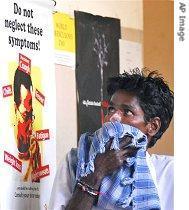-
(单词翻译:双击或拖选)
An estimated one-third of all people are infected with tuberculosis1. Most have latent, or inactive, cases. They do not suffer coughing, increased body temperature or other signs of active TB.
 |
| A tuberculosis patient looks at a TB awareness2 poster in a 2007 photo |
But each year, about nine million people develop active cases and two million die. TB is an ancient bacterial3 disease. It can be cured with antibiotics4, if patients take all their medicine. The victims, though, are mostly poor and live in developing countries.
Now, scientists have reported two new developments in tuberculosis research.
For the past century, a skin test has been the traditional way to identify latent TB. When cases are found, treatment can prevent many from becoming active. But the preventive drugs have a risk of side effects.
The skin test depends on the body's reaction to an injection of specially5 prepared TB protein. But the test often falsely identifies people as having latent TB if they have been vaccinated6 against the disease.
To avoid needless treatment, scientists have developed a blood test. This test is designed to identify patients with a high risk of developing the active form of TB.
Ajit Lalvani from Imperial College London led an international team in developing the blood test, called ELISpot (EL-ee spot). A study showed that the ELISpot blood test identifies latent TB while giving fewer false positive results.
The researchers say the ELISpot test has been recommended for use in about twenty countries worldwide. A report on the new blood test appeared last week in the Annals of Internal Medicine.
In another development, scientists have reported a step toward a better vaccine7 against TB. One currently used is seventy-five years old.
The new experimental vaccine contains a weakened TB bacterium8 from a strain of the current vaccine. The scientists say that in their study, the experimental vaccine created stronger responses against TB than the traditional one.
But the new vaccine contains an antibiotic-resistant gene9 that the scientists do not want released into the environment. So the vaccine will not be tested further. But research will continue on a similar one that does not contain the gene.
Daniel Hoft of the Saint Louis University School of Medicine in Missouri was lead author of a report in the Journal of Infectious Diseases.
And that's the VOA Special English Development Report. It was written by Jerilyn Watson.
 收听单词发音
收听单词发音
1
tuberculosis

|
|
| n.结核病,肺结核 | |
参考例句: |
|
|
|
2
awareness

|
|
| n.意识,觉悟,懂事,明智 | |
参考例句: |
|
|
|
3
bacterial

|
|
| a.细菌的 | |
参考例句: |
|
|
|
4
antibiotics

|
|
| n.(用作复数)抗生素;(用作单数)抗生物质的研究;抗生素,抗菌素( antibiotic的名词复数 ) | |
参考例句: |
|
|
|
5
specially

|
|
| adv.特定地;特殊地;明确地 | |
参考例句: |
|
|
|
6
vaccinated

|
|
| [医]已接种的,种痘的,接种过疫菌的 | |
参考例句: |
|
|
|
7
vaccine

|
|
| n.牛痘苗,疫苗;adj.牛痘的,疫苗的 | |
参考例句: |
|
|
|
8
bacterium

|
|
| n.(pl.)bacteria 细菌 | |
参考例句: |
|
|
|
9
gene

|
|
| n.遗传因子,基因 | |
参考例句: |
|
|
|















